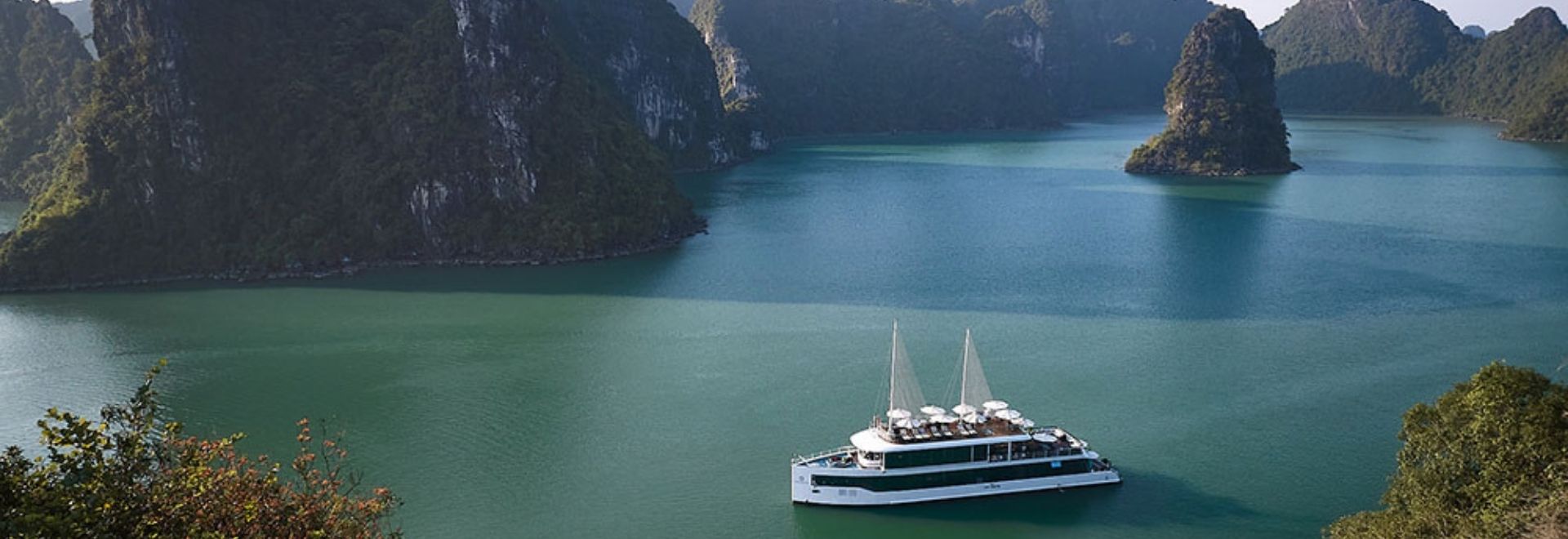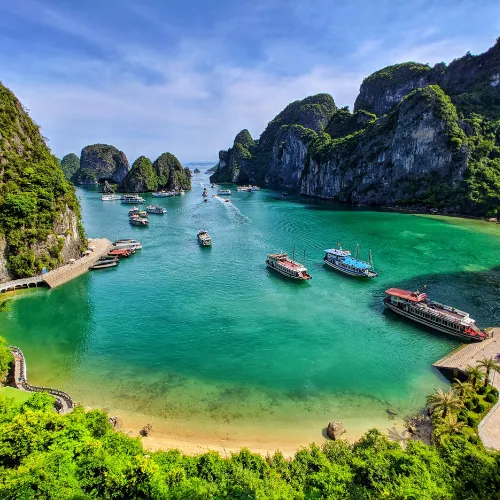Thailand travel guide
From its enchanting rainforests, rambling mountains and lumbering elephants to its far-flung islands, heavenly beaches and kaleidoscopic marine life, not to mention its frenetic cities strewn with glittering Buddhist temples, cloud-piercing skyscrapers and honking traffic, Thailand will impress you at every turn. And then there’s the food. A symphony of flavours and zingy fresh local ingredients — tangy lemongrass, sweet coconuts, chillies that will give you double vision, seafood plucked straight from the ocean — which varies from region to region.
Having honed its place as Southeast Asia’s leading tourism destination over the last 50 years, the Land of Smiles has the widest variety of attractions in the region. Get your big city kicks — temple tours, bargain shopping, eating and drinking at riotous night markets, rooftop bar-hopping — in Bangkok and Chiang Mai. Venture into the countryside — Chiang Rai, Surin, Khao Sok National Park — for supersized jungles, rolling rice fields, fascinating hill tribes and wondrous wildlife. Explore, swim, snorkel and go scuba diving along a coastline that stretches over 3,000 kilometres, from the Andaman Sea in the west to the Gulf of Thailand in the east, peppered along the way with more than 1,400 palm-painted islands. Sail through the emerald karst-studded waters of Phang Nga Bay. Practise yoga along Krabi’s sea cliffs. Catch a Full Moon Party on Koh Phangan. Recuperate a spa retreat on Koh Samui. One thing that Thailand can guarantee is that you will not be bored.
What to do in Thailand ???
Begin by taking a big juicy bite out of the Big Mango. While it’s possible to find the odd flight going direct to Phuket or Chiang Mai, it’s more fun to bookend your trip with a few days in Bangkok, the Thai capital, freewheeling between the Grand Palace, Wat Pho Temple and the Chao Phraya River, and downtown’s shopping malls, street markets, sleek cocktails bars and sensational restaurants.
From here, hop on a luxury river cruise to the beautiful Buddhist ruins of Ayutthaya, (one of six Unesco world heritage sites in Thailand), before taking the train north to Chiang Mai, a creative hub that’s home to hundreds of lavishly decorated temples, art galleries, down-the-generations artisans and — at the top of almost everyone’s Thailand’s wishlist — elephants. Just be sure to do your research to ensure you visit an ethically run sanctuary.
If you’ve a few days to spare, venture to northern Thailand’s bucolic countryside to meditate with monks, float down lazy rivers and marvel at the sun rising above the Golden Triangle’s cloud forests, before flitting south to the tropical island delights of Phuket, Phang Nga and Krabi on the southwest Andaman Sea coast, or Koh Samui, Koh Phangan and Ang Thong National Marine Park in the Gulf of Thailand.
There’s still plenty more to see — Thailand is enormous — from some of the world’s oldest rainforests set in national parks, to the vast varied landscapes of the little visited northeast, to sea gypsy enclaves in the far south.
Where to go in Thailand ???
Deciding where to go in Thailand depends on two things: what you want to do, and when you want to go. The varying areas of the country, from North to South offer visitors a selection of sights, activities and experiences. In this travel guide on the best places to visit in Thailand, we unearth where to enjoy the country’s range of activities, from world-class diving to carousing at lively festivals. Once that’s decided, you’ll need to check the best time to visit.
The clash of tradition and modernity is most intense in Bangkok, which forms the first stop on almost any itinerary. Within its historic core you’ll find resplendent temples, canalside markets and the opulent indulgence of the eighteenth-century Grand Palace. Downtown’s forest of skyscrapers shelters cutting-edge fashion in decor boutiques and some achingly hip bars and clubs.
Most budget travellers head for the Banglamphu district, where if you’re not careful you could end up watching DVDs all day long and selling your shoes when you run out of money. The district is far from having a monopoly on Bangkok accommodation, but it does have the advantage of being just a short walk from the major sights in the Ratanakosin area: the dazzling ostentation of the Grand Palace and Wat Phra Kaeo, lively and grandiose Wat Pho and National Museum.
Once those cultural essentials have been seen, you can choose from a whole bevy of lesser sights, including Wat Benjamabophit (the “Marble Temple”), especially at festival time, and Jim Thompson’s House, a small, personal museum of Thai design.
Chiang Mai
If you’re wondering where to visit in the northern uplands, then start with Chiang Mai. It’s both an attractive historic city and a vibrant cultural centre, with a strong tradition of arts, crafts and festivals.
Self-improvement courses are a strong suit – from ascetic meditation to Thai cookery classes – while the overriding enticement of the surrounding region is the prospect of trekking through villages inhabited by a richly mixed population of tribal peoples.
Plenty of outdoor activities and courses, as well as hot springs and massages, can be enjoyed at Pai, a surprisingly cosmopolitan hill station for travellers, four hours northwest of Chiang Mai.
Many colourful festivals attract throngs of visitors here too: Chiang Mai is one of the most popular places in Thailand to see in the Thai New Year – Songkhran – in mid-April, and to celebrate Loy Krathong at the full moon in November, when thousands of candles are floated down the Ping River in lotus-leaf boats.
Beyond the city limits, a number of other day-trips can be made, such as to the ancient temples of Lamphun – and, of course, Chiang Mai is the main centre for hill-tribe trekking, as well as all sorts of other outdoor activities.
Samui archipelago
The pick of the coasts are in the south, where the Samui archipelago off the Gulf coast ranks as one of the best places to go in Thailand. Ko Samui itself has the most sweeping white-sand beaches, and the greatest variety of accommodation and facilities to go with them.
Ko Pha Ngan next door is still largely backpacker territory, where you have a stark choice between desolate coves and Hat Rin, Thailand’s party capital. The remotest island, rocky Ko Tao, is acquiring increasing sophistication as Southeast Asia’s largest dive-training centre.
Tucked away beneath the islands, Nakhon Si Thammarat, the cultural capital of the south, is well worth a short detour from the main routes through the centre of the peninsula – it’s a sophisticated city of grand old temples, delicious cuisine and distinctive handicrafts.
Central plains
With Chiang Mai and the north so firmly planted on the independent tourist trail, the intervening central plains tend to get short shrift. Yet there is rewarding trekking around Umphang, near the Burmese border, and the elegant ruins of former capitals Ayutthaya and Sukhothai embody a glorious artistic heritage, displaying Thailand’s distinctive ability to absorb influences from quite different cultures.
Even if you’re just passing through, you can’t miss the star attraction of Nakhon Pathom: the enormous stupa Phra Pathom Chedi dominates the skyline.
To get an idea of what shopping in Bangkok used to be like before all the canals were tarmacked over, many people take an early-morning trip to the floating market (talat khlong) at Damnoen Saduak. Sixty kilometres south of Nakhon Pathom and just over a hundred kilometres from Bangkok.
The Andaman Coast
Across on the other side of the peninsula, the Andaman coast offers even more exhilarating scenery and the finest coral reefs in the country, in particular around the Ko Similan island chain, which ranks among the best dive sites in the world.
The largest Andaman coast island, Phuket, is one of Thailand’s top tourist destinations and graced with a dozen fine beaches, though several have been overdeveloped with a glut of high-rises and tacky nightlife.
Beautiful little Ko Phi Phi is a major party hub, surrounded by the turquoise seas and dramatic limestone cliffs that characterize the coastline throughout Krabi province. Large, forested Ko Lanta is, for the moment at least, a calmer alternative for families, but for genuine jungle you’ll need to head inland, to the rainforests of Khao Sok National Park.
Deep South
Further down the Thai peninsula, in the provinces of the deep south, the teeming sea life and unfrequented sands of the Trang islands and Ko Tarutao National Marine Park make this one of Thailand’s top places to go. There’s now the intriguing possibility of island-hopping your way down through them – in fact, all the way from Phuket to Penang in Malaysia – without setting foot on the mainland.
The greatest interest in the deep south is currently all over on the beautiful west coast, where sheer limestone outcrops, pristine sands and fish-laden coral stretch down to the Malaysian border.
Along Trang’s mainland coast, there’s a 30km stretch of attractive beaches, dotted with mangroves and impressive caves that can be explored by sea canoe, but the real draw down here is the offshore islands, which offer gorgeous panoramas and beaches, great snorkelling and at least a modicum of comfort in their small clusters of resorts.
Khao Yai National Park
Another regular in lists of the best places to go in Thailand, Khao Yai National Park – the country’s first national park – encapsulates the phenomenal diversity of Thailand’s flora and fauna. It’s one of the very few national parks to maintain a network of hiking trails that visitors can explore by themselves, passing dramatic waterfalls, orchids and an abundance of wildlife.
Spanning five distinct forest types and rising to a height of 1,351m, the park sustains over 300 bird and twenty large land-mammal species – hence its UNESCO accreditation as a World Heritage Site.
Rangers discourage visitors from exploring the outer, non-waymarked reaches unguided, partly for environmental reasons, but also because of trigger-happy sandalwood poachers. Sandalwood trees are indigenous to Khao Yai, and though oil collection does not usually kill the tree, it does weaken it. Guides can point out trees that have been cut in this way along the trails.
Issan
Few tourists visit Isaan, the poorest and in some ways the most traditionally Thai region. Here, a trip through the gently modulating landscapes of the Mekong River valley, which defines Thailand’s northeastern extremities.
It takes in archetypal agricultural villages and a fascinating array of religious sites, while the southern reaches of Isaan hold some of Thailand’s best-kept secrets – the magnificent stone temple complexes of Phimai, Phanom Rung and Khao Phra Viharn, all built by the Khmers of Cambodia almost ten centuries ago.
Phuket
We may have already mentioned the Andaman Coast, but Phuket is worth looking at in greater detail. Thailand’s largest island and a province in its own right, Phuket is the wealthiest province in Thailand, with tourism driving the economy.
Some tourist developments have scarred much of the island, however, many of the beaches are still strikingly handsome, resort facilities are second to none, and the offshore snorkelling and diving are exceptional.
If you’re after a peaceful spot, aim for the 17km-long national park beach of Hat Mai Khao, its more developed neighbour Hat Nai Yang, or one of the smaller alternatives at Hat Nai Thon or Hat Kamala.
Ko Samui
Despite over a million visitors a year, Ko Samui remains a top places to go in Thailand. Back-packers to bougie fortnighters come to this part of southern Thailand for the beautiful beaches. At 15km across and down, Samui is generally large enough to cope with this diversity and the paradisal sands and clear blue seas have kept their good looks.
The island’s most appealing strand, Chaweng, has seen the heaviest, most crowded development and is now the most expensive place to stay, though it does offer by far the best amenities and nightlife. Its slightly smaller neighbour, Lamai, lags a little behind in terms of looks and top-end development, but retains large pockets of backpacker bungalow resorts.
The other favourite for backpackers is Maenam, which, though less attractive again, is markedly quiet, with plenty of room to breathe between the beach and the round-island road.




